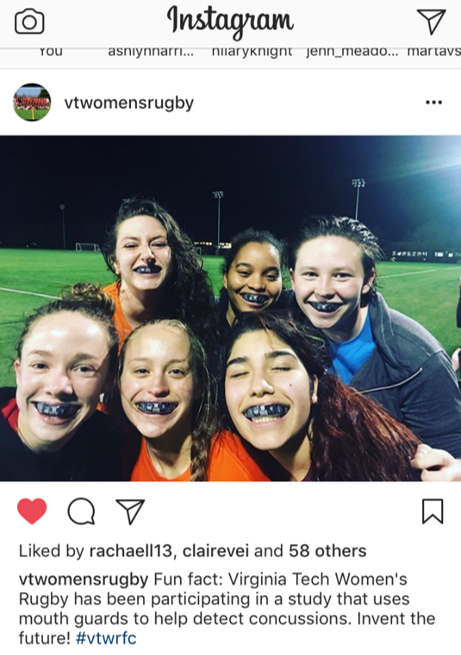Emily Kieffer: Getting ahead of the game with sex-specific differences in head impact tolerance
The following story was written in April 2021 by Angelica Rivera in ENGL 4824: Science Writing as part of a collaboration between the English department and the Center for Communicating Science.


Kieffer, a fourth-year Ph.D. student in the Department of Biomedical Engineering and Mechanics at Virginia Tech, began her research in an effort to expand what we know about female athletes, concussions, and the sex-specific differences in head impact tolerance. She explains that there’s lots of data available on male collegiate football players because we can more easily instrument football helmets with sensors. But because women are less likely to play helmeted sports, there is no similar data set for women.
“We’re missing this huge proportion of the population,” Kieffer says.
With her research, Kieffer explains, she “want[s] to know how hard and frequently people get hit on the head on [the] field and see how that relates to how those people feel and act.” She also is exploring the “accumulation of sub-concussive impacts.” Studying the accumulation is essential because even when a player never has a diagnosed concussion, that player might experience repeated hits on the head by the end of a season. And those hits take a toll.

In a women’s sport that doesn't use helmets, Kieffer found a creative solution to collect head impact data: mouthguards with embedded sensors. She used them in her study of rugby players, collaborating with both the male and female rugby teams at Virginia Tech. Her decision to work with both teams provided the ability to compare head impact exposure in males and females on the field.
With the help of research assistants, Kieffer uses data from the mouthguards and combines them with a symptoms survey that she designed. This survey helps her to monitor symptoms in the season. That’s important, she says, because “there’s a huge underreporting on concussions.” The symptoms surveys are meant to catch small symptoms that players experience that might signal a more severe head injury.

During her undergraduate studies, Kieffer wanted to research neurodegenerative diseases. She found her current passion while working in public health research at the University of Pittsburgh. She enjoyed working with the public and shifted her focus to full-body biomechanics. Coming to Virginia Tech, she interviewed with her now faculty advisor, Steve Rowson. He introduced her to the rugby project that allowed her to integrate wearable sensors to evaluate biomechanics in human subjects.
Kieffer has now finished her research, but not without having experienced some bumps in the road.
“There [were] a ton of issues constantly,” she remembers. “I would take mouthguards to a game, and they just didn’t charge or they wouldn’t connect to Bluetooth.”
Kieffer explains that the mouthguards she used were very new and that she was one of the first people outside the developers at Wake Forest University to use them.

Fortunately, she says, “as the project progressed, the company’s designs progressed as well.”
Despite the bumps in the road, Kieffer knows it’s essential to try to understand further how women respond to head impact exposure. The main goal of her research is “to gain more of an understanding of how these impacts happen and what we can do to decrease them, so that [athletes] can be safer while [they’re] playing sports.”
Kieffer hopes that one day sports can decrease the severity of concussion by giving athletes specific recommendations or by making rule changes. She believes that her data can be a steppingstone that others can use to expand the research available.
“We definitely don’t want to eliminate sports; that’s a huge part of growing up,” she says. “And even into adulthood, being active is super important.”
Kieffer hopes that another student will start right where she left off because her research and findings thus far, she says, are “honestly so cool.” And while concussions are a well-known problem, there are elements of concussions that most people don’t know. For example, people with concussions take shorter steps than usual.
There is still much to discover, but Kieffer has gotten us on the right foot to get ahead of the game.


